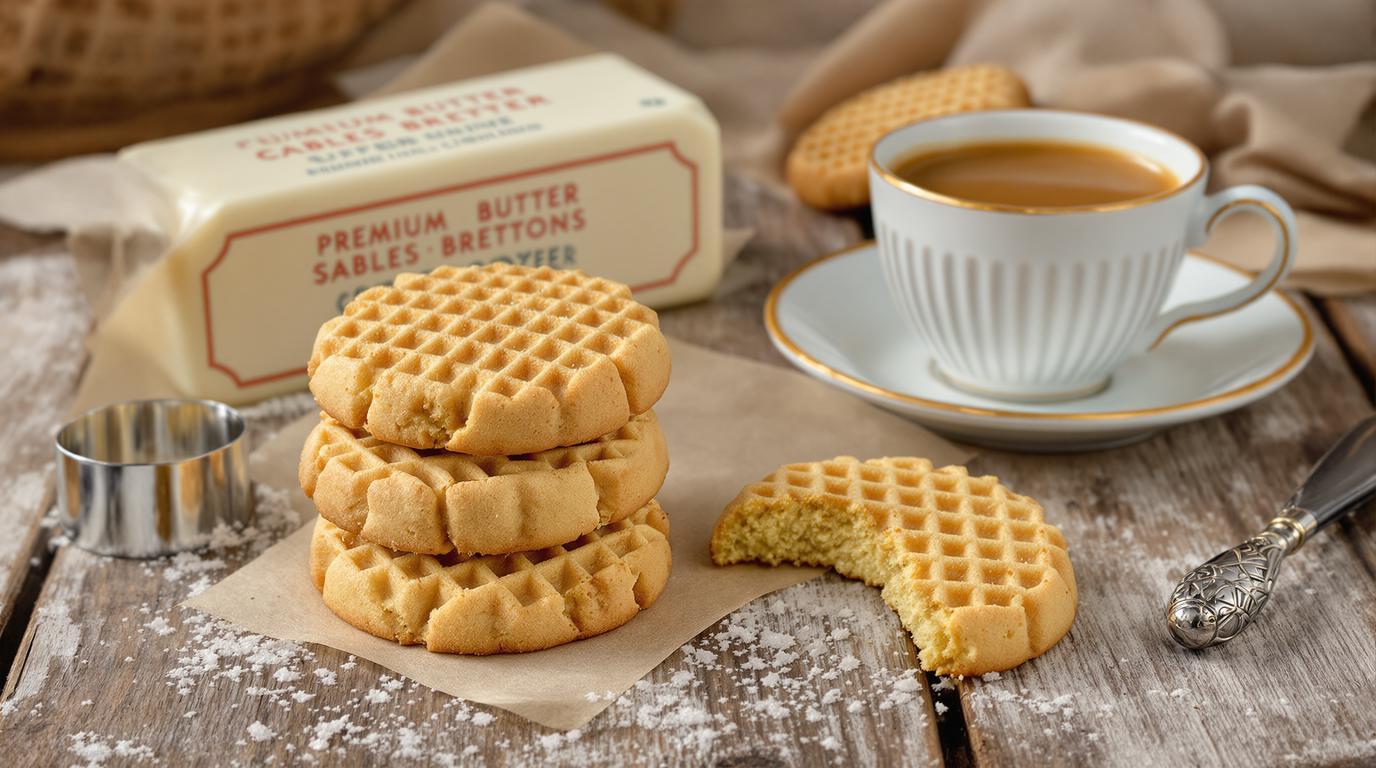I first discovered the magic of Sablés Bretons during my apprenticeship in Brittany, where my mentor insisted we master this cookie before attempting any fancy pastry. “The true test of a baker is in the simplest things,” he’d say, sliding perfectly golden discs from the oven. That distinctive sandy crumb, rich with cultured butter and kissed with sea salt, creates an irresistible contrast that’s both humble and sophisticated. What surprised me most? How the overnight rest transformed ordinary ingredients into something extraordinary – a technique I’ve never abandoned.
The Story
Sablés au Beurre (particularly the Breton variety) are the crown jewels of French butter cookies. The name “sablé” literally means “sandy” – perfectly describing their delicate, crumbly texture. While these cookies appear in bakeries throughout France, the Breton version stands apart with its signature ingredient: salted butter. This isn’t just any salt – it’s the fleur de sel from Brittany’s coastline that transforms these simple cookies into something magical.
Unlike modern adaptations that rely on baking powder for lift, true Breton sablés depend entirely on proper technique and quality ingredients. As one of my first rustic French specialties, these cookies taught me that sometimes, simplicity creates the most profound flavors.
Ingredients Spotlight
For about 20 cookies:
- 250g (1 cup) European-style cultured salted butter, room temperature
- 250g (1¼ cups) granulated sugar
- 3 large eggs, plus 1 egg yolk for washing
- 500g (4 cups) all-purpose flour
- 1-1.5 teaspoons fleur de sel or flaky sea salt
- 15ml (1 tablespoon) milk for egg wash
Chef’s Note: The quality of butter is non-negotiable here. Look for European-style butter with at least 82% fat content – the higher fat percentage creates that distinctive melt-in-your-mouth texture that makes these cookies exceptional. If you can find butter from Brittany (like Bordier), it’s worth the splurge!
Step-by-Step Guide
- Cut butter into cubes and let warm slightly at room temperature until just soft enough to beat (about 65°F/18°C).
- In a stand mixer fitted with the paddle attachment, beat butter and salt until light in color and slightly aerated, about 2 minutes.
- Gradually add sugar and continue beating until the mixture turns pale and fluffy, about 3-4 minutes more.
- Incorporate the eggs one by one, mixing just until each is fully integrated.
- Sift the flour over the mixture and fold gently with a spatula until just combined – the moment you have a cohesive dough, stop mixing!
- Wrap the dough tightly in plastic and refrigerate for at least 1 hour (or ideally overnight).
- Preheat your oven to 350°F (180°C) and line baking sheets with parchment.
- Roll the chilled dough to ½-inch thickness between two sheets of parchment paper.
- Cut into 2-inch rounds using a fluted cookie cutter for the traditional Breton look.
- Transfer rounds to prepared sheets, spacing 1 inch apart.
- Whisk together the reserved egg yolk with milk and brush lightly over the tops.
- Create the signature crosshatch pattern using the tines of a fork.
- Bake for 20-25 minutes, rotating trays halfway through, until the edges turn golden but centers remain slightly pale.
- Cool on the sheets for 5 minutes before transferring to wire racks.
Expert Techniques
The hallmark of professional sablés is their perfect texture – crumbly yet tender, never tough. Here’s how to achieve it:
- Cold butter incorporation: The small butter pockets create the sandy texture as they melt during baking.
- Minimal handling: Unlike other doughs that benefit from development, sablés need just enough mixing to come together.
- Resting period: This isn’t just for convenience – it allows the flour proteins to relax and the butter to re-solidify, preventing spread during baking.
- Temperature control: If your dough feels sticky during rolling, don’t add flour! Instead, chill it again for 10 minutes.
When I’m preparing sablés for special occasions like I might for my signature fruit tarts, I’ll often freeze the cut cookies for 5 minutes before baking. This helps maintain their shape and creates even more defined edges.
Presentation & Pairing Ideas
While perfectly delicious on their own, these cookies shine brightest when thoughtfully presented:
- Stack in a ceramic crock with a ribbon for gift-giving
- Serve alongside a citrus dessert for textural contrast
- Pair with café au lait or earl grey tea for an afternoon treat
- For unexpected elegance, serve with Champagne – the salt-sweet-acid interplay is magnificent
- Create a simple dessert by sandwiching two cookies with salted caramel or berry jam
The beauty of mastering sablés is how they become a foundation for creativity. Try incorporating citrus zest like they do in Alsace, or experiment with adding a whisper of spice. The principles I’ve learned making these cookies have influenced everything from my silky potato purée to my quick pasta sauces – master the foundations, then let your imagination soar. Trust your senses, not just the recipe, and you’ll create something truly magnificent.
